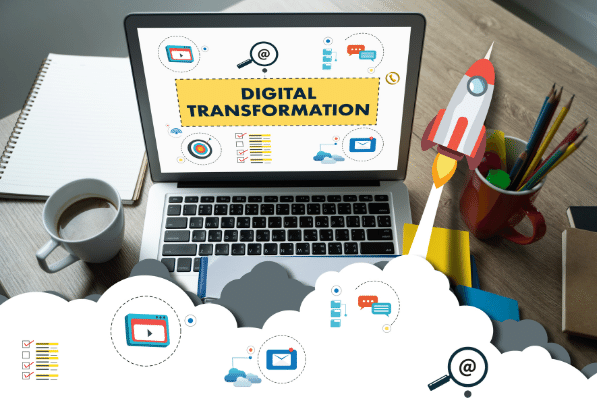Digital transformation has remained the top priority for enterprises globally. This trend will continue in the post-pandemic era as well. In the latest MuleSoft research, hyper-automation, distributed environments, and hybrid experiences will bring new challenges and opportunities for modern businesses in the year 2023 and beyond. In this post, we will see some of the key digital transformation solutions for the future.
Top Digital Transformation Trends Set to Rule in 2023
As technology evolves at a fast pace, it is difficult to predict the trends for digital transformation solutions. But, here we mention a few of them that will remain in the limelight in the coming years.
1. Rise of Semiconductors
Semiconductors have started driving the growth of businesses. Cloud, SaaS, and other technologies have a positive impact on communication, productivity, and efficiency. However, all such technologies result in high demand for chips, and therefore, the year 2021 has become the year known for the chip shortage. Here, semiconductors come into the picture and ensure that such a shortage never happens in the future. Global giants like Intel and Samsung have announced investments of multi-billion dollars for establishing new plants across the world to reduce the production time of chips. We can expect that the impact of this whopping investment will be visible till the end of 2022 and the beginning of 2023.
2. Advent of 5G Connectivity
Still, 5G technology is in the development stage. Complex 5G millimeter waves have a lot of growth potential and we can expect that deployment of such waves will be rolled out soon across the world. Once 5G is implemented, impressive data sharing and communication speed will be achieved. Deployment of 5G millimeter waves (mmWaves) in urban and densely populated environments will start in the year 2022 along with the continued rollout of low-band 5G expansion into rural areas.
Companies like Qualcomm, Samsung, and Nokia are a few of the players that are pushing the development of 5G and 5G mmWave.
3. Post-pandemic Work Approach
This is one of the major trends to watch because the remote work or WFH approach would continue beyond the pandemic as well. Nearly all industries have started offering flexible working conditions and timings across the world. However, these arrangements are challenging and require the assistance of technological advancements. Video conferences can improve collaboration and coordination as employees can stay connected in real-time. Hybrid work advancements include improved VDI experiences and using other advanced tools to make working from anywhere easily for all employees. The change in work shifts also leads to the way we interact and collaborate.
4. Hybrid Experiences and Hype automation
Hyperautomation can unlock productivity, transform the experiences of employees and customers, and reduce time-to-market for enterprises. It is also useful for providing hybrid experiences. When it comes to unlocking the potential of your enterprise and adding value to your business model, hyper-automation always remains a choice for entrepreneurs.
Key benefits of hyper-automation include higher business agility, improved accessibility, increased productivity, and enhanced engagement. It can not only amplify automation at work but also nurtures collaboration across multiple teams. With better data accessibility and actionable insights, the management can easily make crucial decisions for any project at hand.
5. Data Security
Data security always remains the focus for modern enterprises. As companies generate zillions of data every day, it is necessary to keep their storage and access secure. Data security is based on tools and advancements in blockchain and AI technologies.
As most businesses are driven by data, digitization trends are based on making the most of the increasing amount of data. Here, data security plays a vital role in saving confidential information. Therefore, it will remain in limelight in the year 2022 and beyond.
6. AI and ML Technologies
AI and ML-based technologies are developed to solve problems in a better and faster way using the collected data. New AI-based use cases will continue to expand based on the diverse requirements and complexities of enterprises. We can certainly expect that AI will be mainstreamed in the lives of workers and consumers alike. With ML and NLP (Natural Language Processing) concepts, AI will make interactions more interesting and smarter over the period. This concept will also integrate with other emerging technologies including IoT and blockchain to make robust enterprise solutions.
7. Hybrid and Multicloud
Hybrid and multi-cloud are all set to take the digital world to a new level. These concepts can find a universal way for integrating and managing distributed environments. Both these aspects will make digital transformation solutions more powerful and efficient.
In the coming time, multi-cloud service providers will assist companies to store and share data efficiently and securely. It is possible without spending a small fortune. Multicloud solutions are useful in sharing and accessing corporate data everywhere and at any time.
8. Blockchain Technology
This is one of the most promising trends for developing digital transformation solutions in the year 2022 and beyond. Worldwide, cryptocurrencies are gaining ground and the BFSI sector tends to implement blockchain technology for ensuring the high security of online transactions. Concepts like smart contracts have contributed to mainstreaming blockchain technology. As the number of online transactions is increasing at a rapid pace, the importance and prevalence of blockchain technology will grow across various industry sectors.
Concluding Lines
With a focus on data, AI, security, and hybrid experiences, we can expect that digital transformation solutions will bring advanced features to modern enterprises in the year 2022 and beyond. It is fair to mention that 2022 will be a milestone year to bring revolutionary changes in the pandemic-struck corporate world. Let us see how advancing technology contributes to normalizing business activities with these trends.





